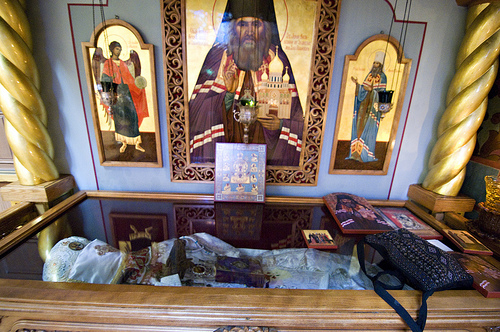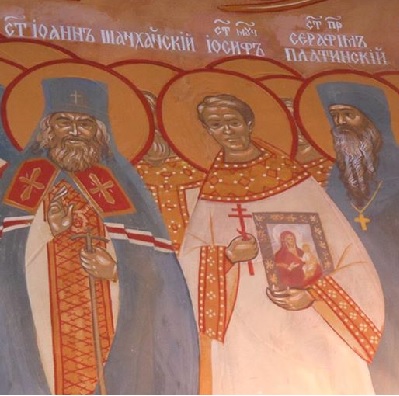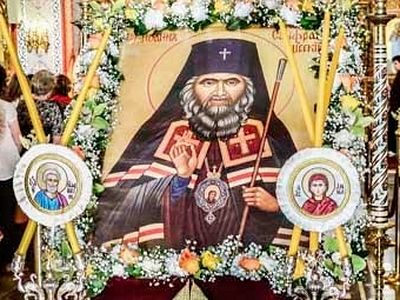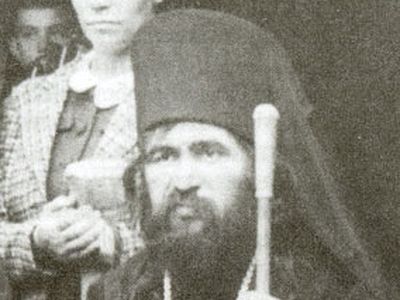In honor of the June 2nd feast of the great hierarch, ascetic, and wonderworker of our own times, St. John Maximovitch, a saint beloved both in Russia and in America and throughout the Orthodox world, we offer below two sources concerning his 1994 glorification. First is a moving article by Fr. Peter Perekrestov, archpriest of the Russian Orthodox Church Abroad's Holy Virgin Cathedral "Joy of All Who Sorrow" in San Francisco, concerning the first opening of St. John's relics in 1993, which preceded his glorification. The second is a video of the beautiful and radiant service of the glorification of this truly universal saint, which occurred in the Holy Virgin Cathedral "Joy of All Who Sorrow."
HOW WE OPENED THE RELICS OF SAINT JOHN MAXIMOVITCH

The relics of John of Shanghai and San Francisco were opened on October 13 1993. The Church marks this event on October 12. Archpriest Peter Perekrestov, an eyewitness of this event, told us about how everything happened.
Vladika John passed away in 1966 while visiting Seattle with the wonder-working Kursk Root Icon of the Mother of God. After the service, he went to his cell and soon afterwards was found reposed before the icon. The funeral was held in San Francisco, but not immediately, because it took quite a bit of time for all the bishops to assemble. Metropolitan Laurus (then Igumen Laurus) and Archbishop Averky (Taushev) traveled for three days by car from Jordanville - almost three thousand miles. Although Vladika John's body had not been embalmed, it showed no signs of decay before or after the funeral service. San Francisco's Board of Supervisors had given the Holy Virgin Cathedral parish council special permission to bury the Archbishop within the city confines, under the church building. We used to have a storage room in the basement. It was this room that was transformed into the sepulcher where Vladika John's remains were laid to rest.
People began going to his tomb before the glorification, as was the case with Blessed Xenia in St. Petersburg. Initially they prayed for Vladika John, but then they started praying to him, leaving him their lists of names. And numerous miracles occurred. I would say that the veneration of Saint John and the process of his glorification began as a grassroots movement and was not one directed from above. His veneration was growing at a rapid pace, and thus the question of his canonization arose relatively soon. However, it was a great miracle that a decision regarding his canonization was made.
At that time, the head of our Russian Church Abroad was Metropolitan Vitaly (Ustinov), and it is no secret that he had not been favorably disposed toward Archbishop John. As a result, Vladika Vitaly was not very popular in San Francisco. Nevertheless, Archbishop Anthony (Medvedev), who was the ruling hierarch of the Western American Diocese, told me after he returned from the Synod meeting in September 1993: "You won't believe what just happened. At the Synod meeting, I suggested that materials for the possible glorification of Archbishop John be collected, and Metropolitan Vitaly unexpectedly said: 'Let's glorify him'!"
After this turn of events, it was decided to open Vladika John's remains. Archbishop Anthony invited Archbishop Laurus, to whom he was very close and trusted greatly, as well as several priests, including an archimandrite who used to be Archbishop John's main acolyte. The keeper of the sepulcher was also invited.
For some reason, there are particular days where every single detail is remembered. Father Alexander Schmemann reflects on this in his diaries. We can forget details of very important days: our wedding or ordination days, but some days and moments are never forgotten. We recall every detail: what the weather was like, the color of people's clothing. For example, although I served with Archbishop Anthony (Medvedev) for twenty years, I remember only certain moments well. I can close my eyes and feel him sitting nearby, see him separating his Panagia and Cross on his chest, and clearly see his exact facial expression. In the same way, I remember the day when holy Vladika John's relics were opened: It was like a small Pascha.
I think most of us have never opened up a coffin after twenty five years have passed since the burial. From a human perspective, I felt trepidation and some reluctance before the opening of St. John's remains. I was a young priest, and I honestly couldn't say I felt too comfortable around dead bodies. At about 9:00 p.m. we went down to the sepulcher and began serving a Panikhida. Our wives and children knew about this. Although Vladika Anthony asked us to keep this a secret, we convinced him that we could not keep this a secret from our wives. They would ask where we were going at that hour. Vladika Anthony then gave us his permission to tell them.
They were waiting for us at home with great anxiety. Several days before the opening of the relics, a small delegation had gone down to the sepulcher to investigate things. The delegation consisted of three clergymen, one of them being a carpenter. The casket was in an aboveground concrete sarcophagus. The delegation needed to know in advance how the extremely heavy cover of the sarcophagus would be removed. Because of their efforts, when we went to open the remains, we knew what needed to be done. Two-by-fours, a crowbar, sheets, and other items had been prepared. We lifted the cover of the sarcophagus and saw a corroded metal casket under it. The casket was covered by a bishop's mantle, the one that had been put there on the day of Archbishop John's funeral. The mantle was intact. Then the coffin was raised slightly with ropes, but it started to collapse because it had completely rusted through in many places. So we put the two-by-fours under the casket to support it. The next step was to open the casket lid.
 St. John Maximovitch, the martyred Br. Jose Munoz-Cortes, Blessed Hieromonk Seraphim Rose
St. John Maximovitch, the martyred Br. Jose Munoz-Cortes, Blessed Hieromonk Seraphim Rose
I would like to step back for a moment and recall the events that led up to this. When my wife and I were deciding whether or not to move to San Francisco, she was quite hesitant, because we would be living very far from family. In the Russian Church Abroad, we do not have such a strict policy in regards to clergy assignments and transfers like they have in Russia. Usually a bishop will make a proposal and the priest can either agree or refuse. The quandary is that many of our priests have secular jobs, and not everyone can leave his job, because not every parish can provide its clergy with a decent salary. So we went to San Francisco for a "scouting" trip. I had more superficial reasons for moving there. I was thinking of the grand cathedral, of the numerous youth, the large Russian population, and the active parish school. But my wife was a bit skeptical about those things. We saw the city, got to meet some of the clergy, and right before our departure were invited by Vladika Anthony to his residence. Archbishop Anthony lived alone. He did not have a cell attendant or a driver. He would usually use the city buses and always carried a briefcase with him. When he went shopping, he would even put his food purchases in that leather briefcase. The Archbishop greeted us at the door, sat us down, and started to cook everything by himself. When the food was ready, he faced the icon corner and said the Lord's Prayer. My wife later remarked that she had never seen anyone reading "Our Father" in such a way. Vladika Anthony was not simply reading a prayer; he was standing before the living God, addressing Him. There was no formal element in his prayer. When we left Archbishop Anthony's quarters, I asked my wife: "Well Lena, what do you think?" and she replied: "With a bishop like that, one can live and serve anywhere." That was the deciding factor for us in regards to our move to California.solemnly put the key into the keyhole, but the lid would not open. It had rusted through, and the lock did not work. Then our protodeacon got down to business and tried to force open the lid with a crowbar. He was a very strong Russian and weighed around 375 pounds. However, Archbishop Anthony did not approve of this use of brute force, believing it is not proper and pious to open the lid in such a manner, so he stopped the protodeacon, crossed himself, closed his eyes, and started reading the 50th Psalm.
This same bishop was praying during the opening of St. John's relics. Vladika Anthony completed Psalm 50, took the lid, and it opened with ease. It is my opinion that we could not open the lid from the very beginning because God wanted the relics to be uncovered by Archbishop Anthony, a man of high spiritual life and purity. The lid opened, and we glimpsed St. John's vestments. Initially they were white but now had become green. It seemed they were moldy. We then touched the vestments, and they fell apart in our hands because of decomposition. When a priest is buried, his face is covered with an aer: the one that is used to cover the Holy Gifts at the Liturgy. Such an aer was covering St. John's face. Archbishop Anthony crossed himself and raised up the aer covering Vladika John's face. This was the moment when I saw Archbishop John's face for the first time. His face and body were intact - they were incorrupt - and we were laying eyes on true relics.
Vladika Anthony appointed me the photographer of this event. I was taking pictures with a film camera (this was 1993). I ran out of film and rushed home. All the lights were on in our apartment-it was like the Pascha. Although it was around midnight, my wife was waiting for me. I began saying loudly: "He is incorrupt! His relics are incorrupt!" I then grabbed some film and ran back to the sepulcher. Matushka started to phone others to share our joy. When I came back to the sepulcher, a sick boy was brought to the relics who was a son of one of our diocesan priests. Archbishop Anthony gave his blessing for the boy to touch the relics. And the boy was healed. Now he is completely healthy, much taller than I, and plays college rugby. A wooden casket had been prepared in advance to replace the metal one that had rusted away. We placed the relics in the wooden casket, closed it, and left the sepulcher praising God.
The preparations for the glorification were moving ahead quickly. New vestments were being sewn for St. John. In several months, we opened the relics a second time in order to wash them and vest Vladika, but we were not sure how to go about doing this. There was no reference book with detailed instructions on relics are to be washed and prepared before a glorification service. Archbishop Anthony was searching all his books. He did find some historical data on canonizations, including a description of how St. Theodosy of Chernigov and St. Ioasaph of Belgorod were glorified by the Russian Orthodox Church. He also found some articles in the publication The Church Herald and other old periodicals. There was some information there, but we had to figure out most things for ourselves. In Russia, perestroika had only just begun, and the opening of relics was not yet widespread. There was nobody to ask. We washed St. John's relics using water, oil, and rosewater. Initially, his skin seemed light in color, almost white, but it turned a rather dark amber color after it was washed. I combed out his hair and beard (I even found several hairs in the comb afterwards). We changed his vestments and left him in the sepulcher until 1994, when he was glorified on the day of his repose, July 2.
Before St. John Maximovitch's canonization, the Russian Orthodox Church Outside Russia had canonized Blessed Xenia of St. Petersburg, St. John of Kronstadt, and the New Martyrs of Russia. There were many requests and pleas that these saints be glorified. Even St. Nicholai (Velimirovic) of Serbia had written to the Synod of Bishops asking ROCOR to glorify St. John of Kronstadt. Metropolitan Anastassy, who was the First Hierarch of ROCOR at that time, was against the idea of canonizing St. John of Kronstadt because he felt that such an act might in some way usurp the full authority of the whole Russian Orthodox Church. When Metropolitan Philaret was elected First Hierarch, though, the glorification of St. John of Kronstadt did take place.
The glorification of St. John of Shanghai and San Francisco took place as follows: First, the relics were brought from the sepulcher to the cathedral proper and placed in the center of the church. A Panikhida was then served, the last one for Archbishop John. At the end of the Panikhida, an icon of St. John, wrapped in a cloth, was laid upon the closed reliquary. The Panikhida finished with the words: "May God bless and give him rest, and by his holy prayers have mercy on us." After the Panikhida, the All-Night Vigil began at which the stichera (verses) to the new saint were sung. During the litya, when a list of saints is remembered, St. John was mentioned for the first time: "our father among the saints John, Archbishop of Shanghai and San Francisco the Wonderworker, whose glorification is presently taking place, and all the saints..." That Vigil was unforgettable!
During the polyeleos, the Metropolitan came up to the reliquary, untied the icon of St. John that was on top of it, and two tall priests raised it on high so the faithful could see it. Afterwards, the reliquary lid was lifted and everyone could see St. John's relics. Immediately, all present did a full prostration and the numerous clergy sang the Magnification to the new saint.
The glorification service was beautiful and truly conciliar, with the participation of numerous faithful. It was also one of the most important spiritual events in my life. And I will not cease to remark that our generation is truly an extremely blessed one. Not one generation has received so many mercies from God as we have: We have not experienced wars, and we have witnessed the rebirth of church life in Russia and the glorification of the New Martyrs and St. John. In addition to these blessings, we have witnessed and taken part in a great and unprecedented miracle: the unification of the two parts of the Russian Church!



